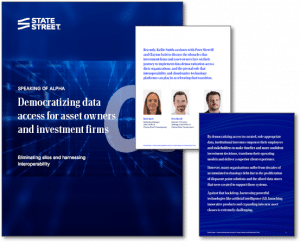Eliminating Silos and Harnessing Interoperability.
By democratizing access to curated, role-appropriate data, institutional investors empower their employees and stakeholders to make timelier and more confident investment decisions, transform their operating models and deliver a superior client experience.
However, many organizations suffer from decades of accumulated technology debt due to the proliferation of disparate point solutions and the siloed data stores that were created to support those systems.
Against that backdrop, harnessing powerful technologies like artificial intelligence (AI), launching innovative products and expanding into new asset classes is extremely challenging.
Recently, Kellie Smith sat down with Peter Sherriff and Clayton Issitt to discuss the obstacles that investment firms and asset owners face on their journey to implement data democratization across their organizations, and the pivotal role that interoperability and cloud-native technology platforms can play in accelerating that transition.
Kellie Smith
Marketing Manager, Asia Pacific
Charles River
Peter Sherriff
Director of Product Strategy, Asia Pacific
Charles River
Clayton Issitt
Head of Alpha Client Solutions, Asia Pacific
State Street
Why do data silos present challenges to democratizing data across an organization, whether that’s asset owners or investment managers?
Peter: Data silos are a silent productivity killer. As these silos were created across decades, firms have tried to solve the challenges they present by adopting enterprise data management solutions to create security master records. When these systems are not bidirectionally integrated across the enterprise they can compound the problem.
Once data silos take hold at a macro level, smaller silos start to proliferate because teams combine information from larger silos across the organization to support their workflows and areas of responsibility. This results in significant operational overhead to aggregate and manipulate data. At the recent Investment Data and Technology summit in Sydney, an industry data expert pointed out that “you don’t want to be doing your mastering after you’ve done your mastering.” With data silos, data mastering may occur in the legacy data management tool, but further downstream other teams may perform their own localized mastering. This adversely impacts people’s primary roles by creating localized data governance and validation processes, preventing streamlined access to role-appropriate data across the organization.
Clayton: Investment professionals have problems they need to solve, and they build or acquire specific technology solutions to address these needs. The solution may solve a problem sufficiently, but often they are not interoperable with other technology applications. As firms acquire other businesses or expand into new geographies, asset classes or strategies, these problems tend to proliferate. Simply stated, point solutions do not scale effectively.
The challenge of scaling point solutions comes from the need to continuously re-validate the same data as it is ingested into each additional system. The result is a complex landscape of systems that have difficulty synchronising changes across them. Addressing this operationally quickly becomes inefficient and costly.
Kelly: It’s interesting to hear how these challenges have evolved over time and why data silos are surprisingly commonplace. In our Data Opportunity survey of over 500 institutional investors, three quarters of respondents rated their current data capabilities across the board at a nascent or intermediate stage of development.
Most singled-out data accuracy, access, analytics, governance, and data integration as key areas for development. This has ramifications for customer retention and revenue growth. Forward-looking firms that acknowledged having a data management strategy in place say they experienced a 24 percent increase in customer satisfaction, a 21 percent increase in customer retention and a 19 percent increase in revenue growth on average.
“As firms acquire other businesses or expand into new geographies, asset classes or strategies, these problems tend to proliferate. Simply stated, point solutions do not scale effectively.”
How are emerging financial desktop protocols like Financial Desktop Connectivity and Collaboration Consortium (FDC3) helping investment firms and asset owners improve interoperability between their accumulated legacy systems?
Peter: I think “emerging” is the right word in describing this space, having recently consolidated from three providers down to two main offerings. We’re seeing a lot of interest from both clients and vendors like ourselves in how FDC3 can improve contextual data communication to streamline and enhance workflows.
Additionally, these protocols have the potential to improve collaboration across the organization by providing an interconnected and interoperable set of core applications that understand each other’s workflows and the transaction life cycle.
We are working with a number of clients to define and implement use cases across internal and third-party solutions such as streamlining foreign exchange (FX) execution by connecting to Charles River Development’s front office desktop solution with State Street’s liquidity venues. The contextual awareness between the desktop solutions provides traders with the information needed to execute it in the most efficient way.
Instead of having to send data between applications or create and upload Excel extracts into the next tool, FDC3 dynamically connects these applications in real time, creating efficiencies and facilitating greater collaboration.
We do see some wariness from vendors with regards to what they expose to other parties in the process. Whilst there is growing interest in promoting the adoption and growth of desktop protocols, the industry is still ascertaining how to protect its IP and competitive advantage.
Clayton: Our clients want to interact with fewer partners, and they want this group of partners to play well together to provide their end users with a better experience. In the previously mentioned survey, 60 percent of respondents rate their interoperability across front, middle, and back-office operations as average, below average, or inadequate. When asked what value their organizations would gain from better connectivity between the front- and back-office, respondents selected smarter collateral management by identifying cheapest-to-deliver securities, followed by understanding drivers for fund redemptions, and improved transparency and collaboration between teams.
We see the value in facilitating connectivity and have invested a lot of time and resources in identifying and building relationships with like-minded partners to serve our clients. From performance attribution and risk analytics to data and application providers, we are striving for greater interoperability with our partners.
In our partner ecosystem, we’ve also taken a client centric approach by democratizing data access across the investment organization and ensuring seamless data access across that firm’s partners, whoever they may be.
24%
Forward-looking firms that acknowledged having a data management strategy in place say they experienced a 24 percent increase in customer satisfaction.
Why are cloud native solutions increasingly imperative to the future of investment management?
Clayton: Cloud native solutions have become table stakes because they remove friction and inefficiency from investment operations. Traditionally, firms created data in the front office, perhaps built or acquired a middle-office book of record and managed numerous back-office data feeds. This required the construction of interfaces and constant reconciliation to deliver that data into different applications across the enterprise.
The cloud enables meaningful interoperability between disparate applications and data stores for clients. Instead of engaging in time-consuming data movement to feed applications, we can now bring the applications to the data by leveraging cloud native solutions like Snowflake®.
This reduces a lot of ETL (extract, transform, load) overhead and time-consuming manual reconciliations so clients can start transitioning from high volume, low value, and expensive IT operations to higher value activities.
Peter: A key benefit of cloud native architecture is increased agility. Having all your data available in the cloud makes innovations like the Snowflake Marketplace possible. Quants and data analysts gain access to new and differentiated data sets that might help them generate alpha, design new ETFs, or build responsive risk models.
Just five years ago, quants would identify a data set of interest and then go through an extensive internal process to gain access to a sample set of data delivered as a file. They would then need to write code to upload it into a data repository before they could analyze it.
Now, via a cloud shared sample of data accessed through a marketplace, they can load it immediately into their existing environment and promptly begin their analysis. The amount of flexibility and agility this affords analysts is unprecedented.
Moreover, leveraging cloud native solutions enables structured and unstructured data to be combined and synchronized easily. Legacy data repositories were mostly relational databases not meant for storing the diverse sources of unstructured data that are increasingly critical for generating enhanced analytics and managing private assets. Cloud native solutions enable fit-for-purpose data stores that provide a single, homogenized access layer for both structured and unstructured data. Firms no longer need to manipulate unstructured data into a structured view.
Kellie: Investment firms are now seeing these benefits. Slightly more than 40 percent of survey participants noted that on average, they need to upgrade at least half of their existing technology to meet their data-related goals.
A resounding 98 percent of respondents reported being open to outsourcing their data technology needs and almost half are actively looking to outsource multiple data operations.
“As firms acquire other businesses or expand into new geographies, asset classes or strategies, these problems tend to proliferate. Simply stated, point solutions do not scale effectively.”
What is the benefit of seamlessly coupling financial information and investment data, whether that data is provided by analytics, ESG or data providers?
Peter: From an asset owner perspective, it’s increasingly important to deliver a whole-of-fund view across public and private markets for both internally and externally managed assets. This involves capturing and curating structured and unstructured data from multiple sources and providers. Alongside the challenges of capturing information in a timely fashion from external asset managers, firms need to combine that with the decisions being made internally to ensure they are not working against themselves in the market or doing something today that may conflict with an investment decision previously taken by an external manager.
A consistent and accurate whole-of-fund view empowers more informed decision-making. This could, for example, allow a portfolio manager to reduce their cash buffer from five percent to three percent so they can be fully invested. In the case of an extreme market event, knowing what your external managers are doing will enable a dynamic response. Asset owners have historically found it challenging to centralize and streamline all the financial information and investment data. However, with the right technology and trusted service providers, it is now possible to get a holistic view of the data they need.
Enriching investment data with financial data accelerates our ability to bring applications to the data. This means that we can incorporate third party data from risk and analytics vendors to enrich data sets that are being used for critical decision making — whether that is about informing risk concentration in a fund, understanding where things are deviating from benchmarks, or identifying where they’ve got pockets of return to lock in.
Clayton: This enables clients to have a data set encompassing front, middle and back-office together in a single model with multiple consumption options that support different personas. Whether you are an executive in need of a curated report, or a developer who only operates in Python, it is critical to provide an equivalent, high quality experience to meet their needs, underpinned by the same clean and trusted data sets.
We now provide this for our clients — from front to back, public to private — in concert with partners that offer reporting, cataloguing and lineage capabilities to help users understand what is taking place across their fund.
Peter: This is also where the partner ecosystem is critical. It’s not just about getting information into a single place; it’s about sharing it with the rest of that ecosystem so that everybody in the organization is working off a consistent set of trusted information. We’re extending the democratization of data to our platform partners like FactSet and MSCI. In practice, this means we have the ability to share financial information from these platforms to ensure consistent pricing and analytics data is available to all parties. No matter who in the organization is looking at that information, it’s consistent and well governed.
“As firms acquire other businesses or expand into new geographies, asset classes or strategies, these problems tend to proliferate. Simply stated, point solutions do not scale effectively.”
98%
A resounding 98 percent of respondents reported being open to outsourcing their data technology needs and almost half are actively looking to outsource multiple data operations.
“As firms acquire other businesses or expand into new geographies, asset classes or strategies, these problems tend to proliferate. Simply stated, point solutions do not scale effectively.”
Contact Us
To learn more about State Street Alpha® or to schedule a demo.
6062017.1.1.GBL.
The material presented is for informational purposes only. The views expressed in this material are the views of the author, and are subject to change based on market and other conditions and factors, moreover, they do not necessarily represent the official views of Charles River Development and/or State Street Corporation and its affiliates.




